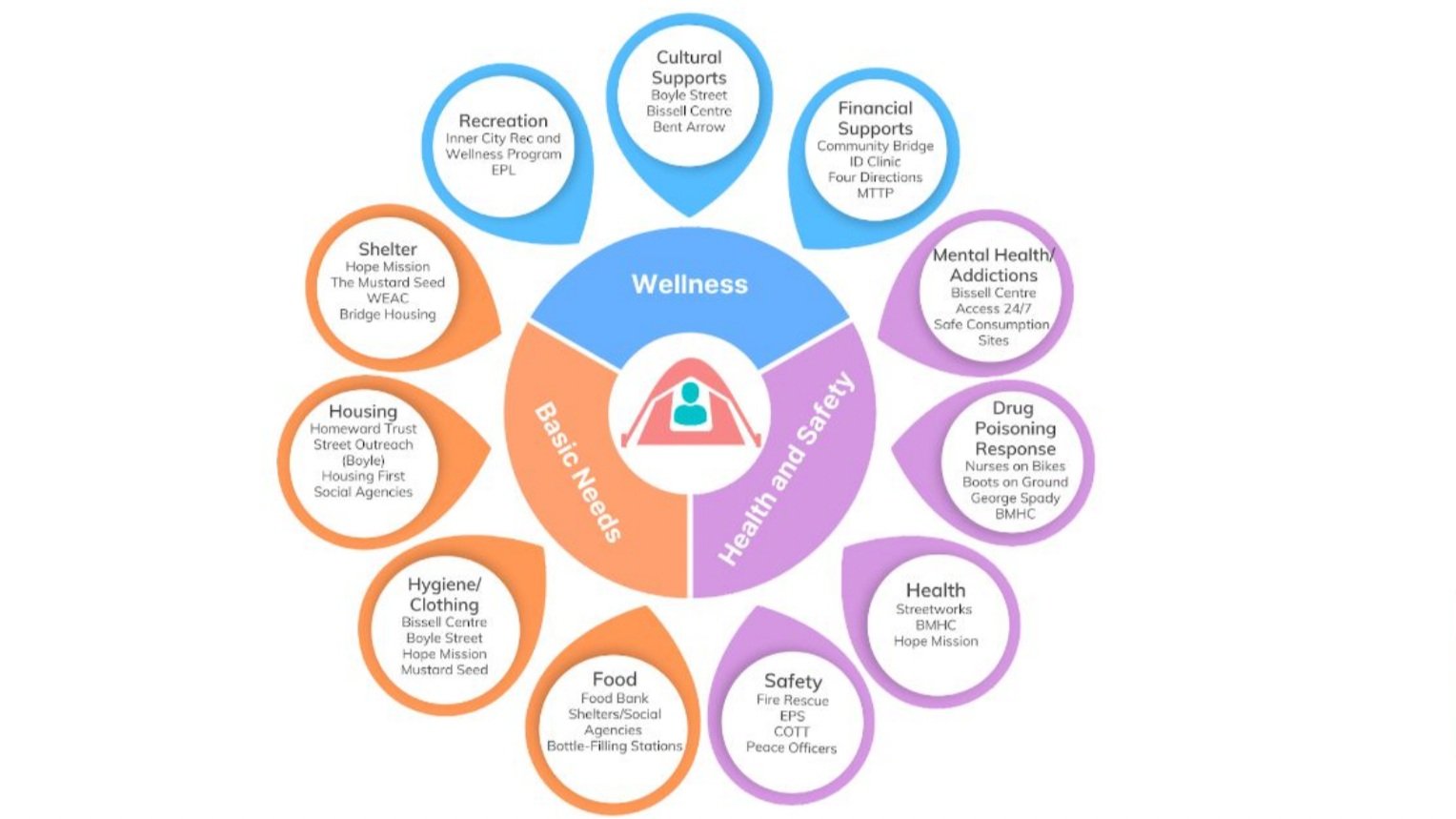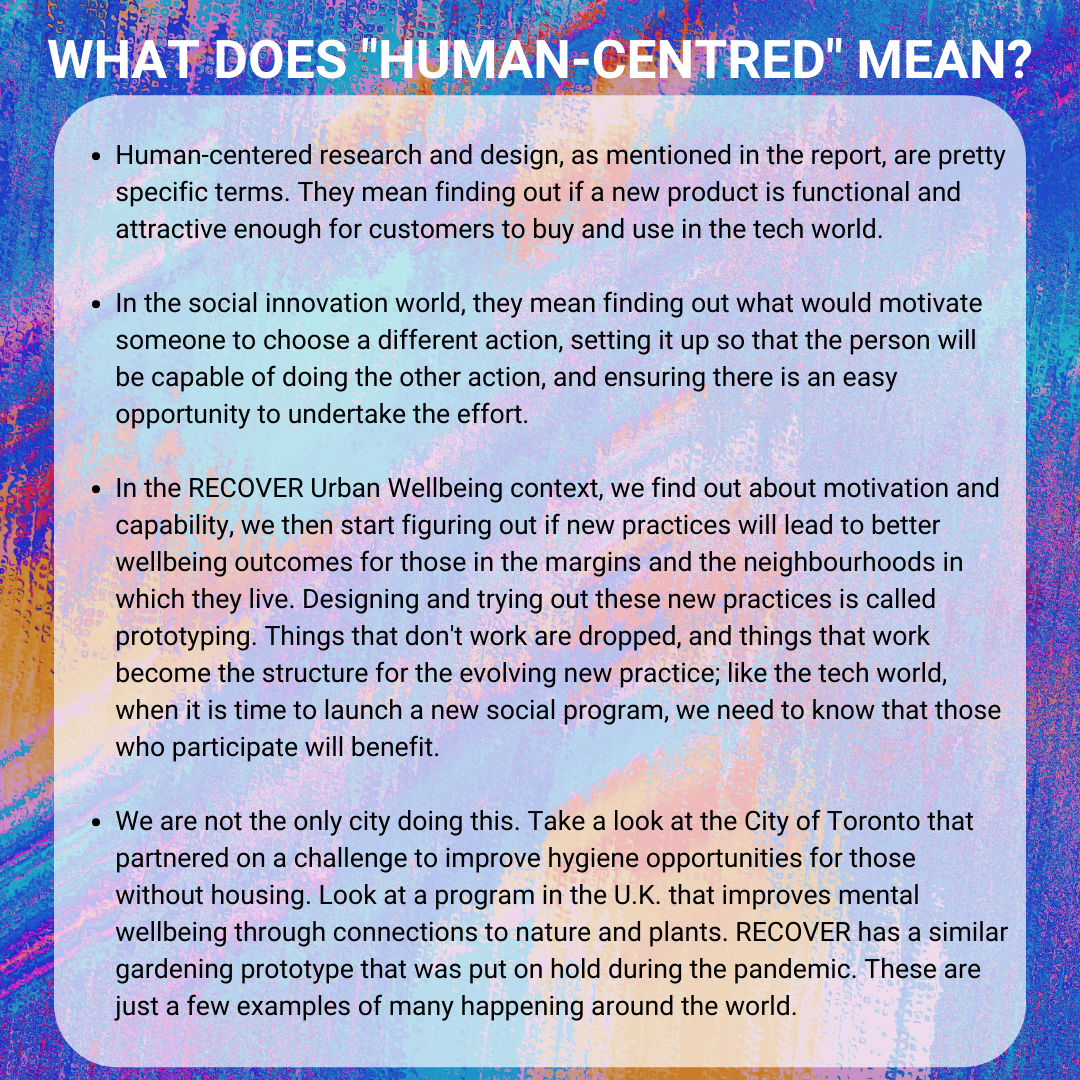Reflections on the Homelessness and Encampment Response Strategy
Image Source: Homeless Supports in Edmonton, Homelessness and Encampment Response Strategy, Presentation to City Council Community and Public Services Committee, April 25, 2022
As the weather warms up, we are going to see more encampments in the downtown core, and likely more tents elsewhere across the city. The issues of encampments and so called “tent city” are not new, and have been on the rise for the last few years. The pandemic, like with everything else, exacerbated this. In fact, given the significant increase in the houseless population in the last couple of years, rising from 1,700 to now 2,800+ people, some of us worry that this year's encampments might be the worst Edmonton has ever experienced – in terms of living conditions, the impacts on the surrounding neighbourhoods, and the resources required.
That’s why the “Homeless and Encampment Response Strategy” that we discussed last week on April 25th was so highly anticipated by many of us on Council. (See the presentation, read the Council report).
After delving into the report, I’ve been reflecting deeply on it over the last week, and my biggest take-away from the report and strategy is that we are asking the wrong question - whether or not we should sanction encampments on public land is only a piece of the puzzle. I think we need to also ask - how do we make life better now? We all have our eye on the end goal of housing for all and everyone living their definition of a good life. In the meantime, we are challenged with improving wellbeing in the current situation of not enough housing and wellbeing opportunities. With these questions in mind, I can’t shake off the feeling that the strategy is missing a few key pieces, and I’d like to offer my constructive thoughts on what else needs to be part of the approach.
Where is the Wellbeing Lens?
I had the privilege of working on the City of Edmonton’s RECOVER Urban Wellbeing Project from 2018-2020 as the project manager. This work continues to this day as the team builds out prototypes and initiatives shaped by the very lessons we learned from talking with Edmontonians. The project is well documented with a ton of data, information and publications - all available on the project's website.
After having spent several years working in the space of urban wellness and social research design, starting from the lived experiences of people most impacted by policy decisions, understanding their perspectives, hopes, and fears, we’ve learned a lot about what Edmontonians living rough want as outcomes for themselves.
Our team spent many days on the ground with people, whether at McDonald’s sipping late night coffees, or going along with someone on their bottle picking routes, or even sitting together in a tent in the river valley. We listened, shared, observed people’s routines, habits, stories, their strengths and weaknesses, fears and aspirations.
Through thousands of conversations, we precipitated data that informed the question “What are the outcomes you want to see for yourself?” The top four outcomes that emerged were respect, safety, connection, and purpose — for both Indigenous and non-Indigenous folks alike. This is the end that many people are striving for.
So where is housing and shelter in these top ranking outcomes? It is up there, and certainly for some it is an outcome they want. But for many others, housing is a means to get to the end of “respect, safety, connection, and purpose.”
Understanding this piece is critical: housing/shelter/camp is not always the end itself, it can be a means to an end. As decision and policy makers, we then need to ask ourselves, “are sanctioned encampments the answer to get at respect, safety, connection, and purpose? Can there be other avenues to achieve this for those who are choosing to camp outdoors?” Certainly diversion to housing resources will be one path, but can there be others?
Where are the Lived Experiences and Human Voices?
Based on my experience working on RECOVER, I know the City has done research on improving well-being, working with Edmontonians living on the margins, along with literature and program reviews from around the world. This work also has some starting ideas that engage people living on the margins like micro-shelters and yurt communities. But this existing research was missing from the presentation and report on the Homelessness and Encampment Response Strategy for me.
I was heartened to hear some of the public speakers who registered to speak to the Committee on Monday. Housing advocates want to see a human rights approach to housing. Residents who want to help but who have very few tools other than calling 911 and 311 about the hazards that encampments bring on. A researcher, who worked on the Urban Wellbeing project several years ago, shared some of the stories from Edmontonians from back then that are blatantly missing from the report. She also shared lessons from a recent project with the City of Toronto that relocated folks camping out to housing converted from hotels. All seemingly relevant lessons for us in this conversation that remind us at the end of the day, WHO is going to be affected by any policy decision.
However, the lack of lived experience and voices in the City’s report is revealing. It shows that we will always come at this issue in a way that centres the needs of the institution of our City government. If we want to move towards a human-centred approach as we say we do, then every conversation needs to start, not from a standpoint of liability and risk to the city, but from people and their stories in all their diversity. Except we are not flipping that narrative, no matter how much empathy we have - and I know we have some great people working on the encampment strategy and the outreach teams, people I have worked directly with. Flipping the narrative, for me, means taking a human rights approach.
As the City and its many partners continue to strengthen the wellbeing of those without housing, how can this work continue to build off past work and current work that may not be exclusive to supplying much-needed housing? I am happy the City wants to move forward in building a better future with the people experiencing homelessness. Let's gather all those voices, research, and tested-ideas with the broad goal of people flourishing.
-
Human-centered research and design, as mentioned in the report, are pretty specific terms. They mean finding out if a new product is functional and attractive enough for customers to buy and use in the tech world.
In the social innovation world, they mean finding out what would motivate someone to choose a different action, setting it up so that the person will be capable of doing the other action, and ensuring there is an easy opportunity to undertake the effort. We find out about motivation and capability when we talk to marginalized people. We then start figuring out if new practices will lead to better wellbeing outcomes for those in the margins and the neighbourhoods in which they live. Designing and trying out these new practices is called prototyping. Things that don't work are dropped, and things that work become the structure for the evolving new practice; like the tech world, when it is time to launch a new social program, we need to know that those who participate will benefit.
We are not the only city doing this. Take a look at the City of Toronto that partnered on a challenge to improve hygiene opportunities for those without housing. Look at a program in the U.K. that improves mental wellbeing through connections to nature and plants. RECOVER has a similar gardening prototype that was put on hold during the pandemic. These are just a few examples of many happening around the world.
What Needs to Be Part of the Approach?
I’m not saying we need to overhaul the entire Homelessness and Encampment Response Strategy - it is a starting point. But we do also need to carve out space for better understanding of the issue, spending time with people, and allowing for co-design and experimentation to try out alternatives, however unthinkable they may be for institutions. Sanctioned encampments don't have to be an all or nothing approach. We don’t need large scale encampments, but why not try out something on a much smaller scale with a self governance structure where we get to test new roles for people to give meaning and purpose, where residents in the neighbourhood can take on different kinds of roles. These are the types of feedback we keep hearing from people over and over again. If we keep going with the same approach as past years that saw limited success, what do we have to lose?
What’s Next?
Ultimately, I believe that City Council and City staff are on the same page. We want people without stable housing to be safe and well until they get their housing. We want our neighbourhoods to thrive where residents, businesses, and visitors feel safe and well. We know that illegal encampments spring up because there is not enough housing, or people choose not to use what is offered. And we know that encampments create stress for those who live and work close by.
The strategy has suggested methodologies that we can explore to potentially move in this direction. I hope that Council and the public get to learn along the way. I don’t have a silver bullet solution for this conundrum we find ourselves in, at a scale that we have never experienced as a city. But I’m willing to try and will be putting forward a motion at the next City Council meeting that will at least encourage us to flip the narrative, start from the ground up, test and co-design solutions with those most impacted, and to see if we can surface alternative options.

